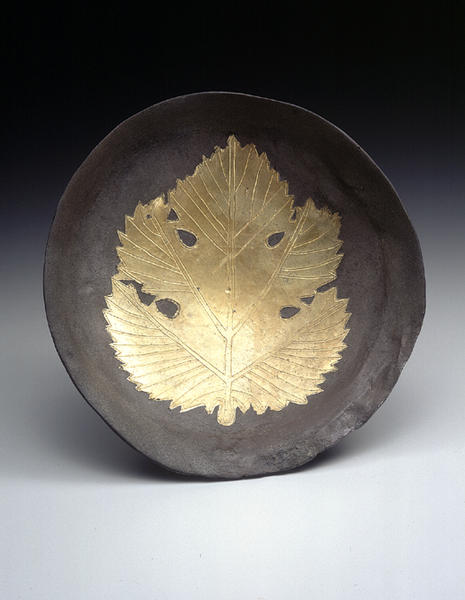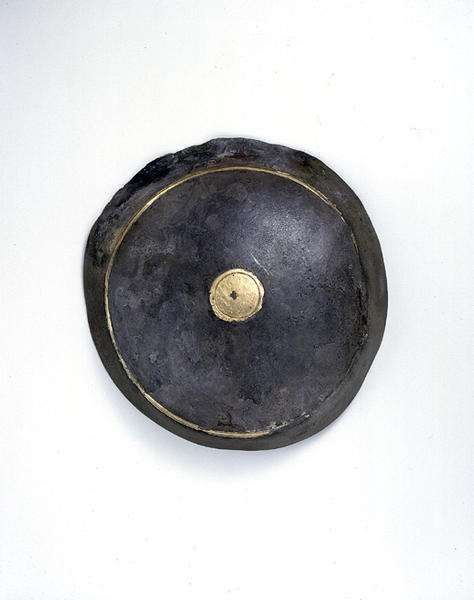Shallow Bowl with a Leaf
- Bactria
- ca. 4th century B.C.
- Gilded silver
- H-5.3 D-19.6
Catalogue Entry
ca. 4th century B.C.
Gilded silver
H. 5.3 cm, Dia. 19.6 cm
This silver bowl has a life-sized plane tree leaf gilded into the center of its interior, giving the bowl a simple, refined mood. The leaf design is not right-left symmetrical, and is thus thought to trace an actual tree leaf. In Greek history, Socrates is said to have sat beneath a plane tree for his philosophy discussions, and thus is known as the wise man's tree. It is also the sacred tree of the river god Acherous. In Bactria, the Oxus River is known as the river's edge where Zoroaster received his revelation, and thus the river was deified and worshipped with the gods related to water sources. An image of the river god Marshas of Magnesia, Asia Minor dedicated to a temple has been found at Takht-I Sangin and this figure of Marshas coincides with that of Zoroaster. There was a large settlement of Magnesia peoples near Takht-I Sangin and it is thought that they transferred their customs to the worship of the river practiced in the Bactrian region. This vessel would have been used to carry something very important to the Magnesia people, and was possibly a vessel used in a ritual involving libations.
Vessels
The "vessels" division is represented by a relatively large number of objects.There are 22 items of gold (cat. Nos. 123-144) and 26 of silver (cat. Nos. 97-122). Among the silver vessels, there are 6 goblets (cat. Nos. 103-106, 108, 109) tall libation vessels Achaemenid in form, but decorated in a style which is typically Hellenistic. Similar cups are held by the magi represented on the relief sculptures and votive plaques. Three rhyta made for a similar purpose are unfortunately in a fragmentary condition (cat. Nos. 118, 119, 122). In addition there are 8 shallow bowls (cat. Nos. 97-99, 101, 102, 111-113) for ritual libations. The gold vessels were used for the same purpose; there are 18 libation bowls, of simple form, most of which have a rounded base and everted rim (cat. Nos. 123-140). One tall vessel of a pyxis type with a lid (cat. No. 142) appears to be the earliest of the vessels in the collection. Of special interest is an incense burner in the form of a censer with four rings for suspension (cat. No. 141).
Although the number of vessels in this collection is considerably larger than those of the Oxus Treasure in the British Museum, they probably served the same function. The vessels of both collections are closely paralleled by the vessels held by worshippers depicted on the Persepolis reliefs. This observation makes it possible to date them. It is worth adding here that the manufacture of goblets of similar shape and of rhyta in the Persepolitan style is depicted on a relief in a pronaos on the northern wall of the tomb of Petosiris at Hermopolis Magna in Egypt. According to Muscarella, the reliefs attest the manufacture of embossed articles in Egypt right up until 300 BC.
Rhyton with a Stag
Censer
Shallow Bowl with a Rosette Pattern
Shallow Bowl with a Rosette Pattern
Phiale with a Rosette Pattern
Bowl with a Rosette Pattern
Phiale
Fragment of a Shallow Bowl
Bowl with a Rosette Pattern
Bowl with a Rosette Pattern
Bowl with a Rosette Pattern
Bowl with a Rosette Pattern
Bowl with a Lotus and PalmettePattern
Bowl with a Rosette Pattern
Bowl with a Human Heads Decoration
Bowl with a Rosette Pattern
Plate with Ketos
Bowl
Kotyle with Mythical Figures
Situla with a Lion's Head
Rhyton with a horse protome
Horse (Fragment of a rhyton)
Winged Human-headed Bull(Fragment of a rhyton)
Decoration of a Ladle
Disk-like Round Mirror
Lion Griffin (Fragment of a Rhyton)
Shallow Bowl with a Rosette Pattern
Sallow Bowl
Sallow Bowl
Bowl
Sallow Bowl
Bowl
Bowl
Bowl
Bowl
Bowl
Bowl
Bowl
Bowl
Bowl
Bowl
Bowl
Bowl
Bowl
Bowl with Lid

